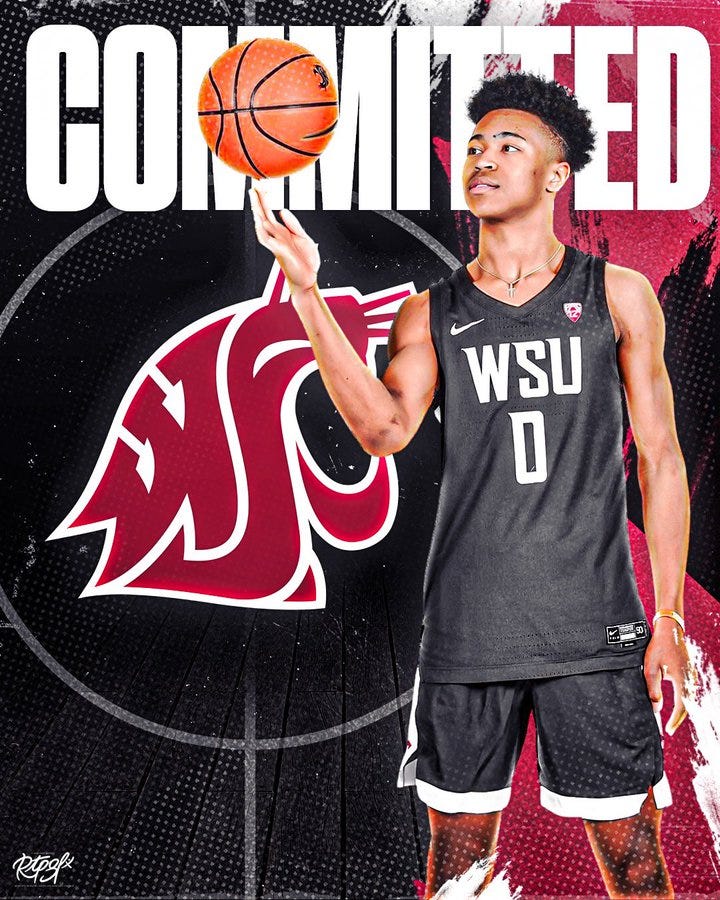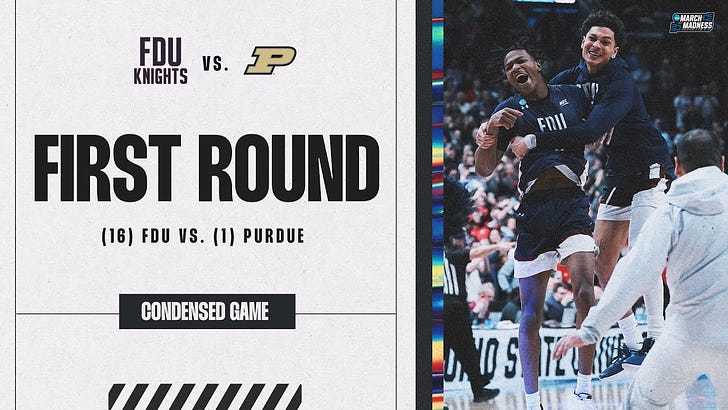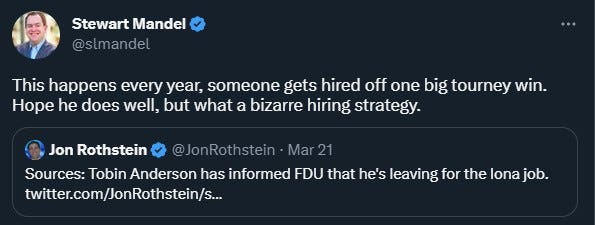Someone in the know once said to me that the difference in a recruit being a low-to-mid-major Div. I prospect and a Div. II target had nothing to do with basketball ability.
Rather, since Div. II universities often have fewer resources as institutions, going the D-II route rather than D-I is sometimes a matter of academics. This isn’t anything new — I first heard this theory as a high-school recruit myself, getting limited interest from a couple low-major Div. I teams and several Div. III and NAIA, but not a single Div. II.
However, the 2022-23 season may have more so than in any recent campaign highlighted the quality of basketball being played in Div. II — and its potential impact on Div. I.
Some of that potential has already been realized.
College of Charleston emerged as one of the leading stories of ‘22-’23, winning 20 consecutive games at one point and coming minutes away from upending eventual national runner-up San Diego State in the 1st Round of the NCAA Tournament.
Spearheading the Cougars’ best season since 1997 was Dalton Bolon, a super-senior transfer from West Liberty University. Bolon earned Div. II All-American honors at West Liberty, then utilized the extended eligibility granted after the COVID pandemic to attend Charleston.
There, he flourished alongside former WLU teammate Pat Robinson III.
Charleston coach Pat Kelsey and his staff continue that pipeline from West Liberty into 2023-24 with the addition of Bryce Butler. Butler averaged north of 22 points per game for the Hilltoppers this past season en route to the Div. II National Championship Game (more on that in a moment).
In addition to the WLU transplants, Charleston also relied heavily on 6-foot-10 Ante Brzovic. Brzovic, a Croatian import, spent his first collegiate season at Div. II Southeastern Oklahoma State.
While the post-pandemic transfer portal and its impact on college basketball as a whole is a topic for spirited debate, it has produced success stories. The opportunities afforded Div. II players who either worked their way up to par academically, or who slipped through the recruiting cracks previously, have produced positives.
And, to that end, some of the best D-II ballers of the past season could make a splash in ‘23-’24.
Div. II playmakers proved themselves worthy of power-conference roster spots, like Jaylen Wells. The All-American and standout scorer from Sonoma State is headed to Washington State, joining a lineup with designs on making the 2024 NCAA Tournament.

Likewise, 2023 Tournament team and potential 2023-24 American preseason favorite Memphis adds Jonathan Pierre, the star of 2023 national champion Nova Southeastern.
The rangy Pierre has the potential to grow into a bonafide NBA draft prospect at Memphis after having put his stamp on D-II.
And while individual players successfully made and will continue to make the jump from Div. II to Div. I, so too have full teams.
Queens University of Charlotte made the move this year and emphatically announced its presence with a season-opening win over a Marshall team that went 24-8. The Royals’ 18-15 D-I debut also included wins over 2023 NCAA Tournament teams, including ASUN champion Kennesaw State.
Queens very nearly derailed Kennesaw State’s road to a first-ever Big Dance, too, playing the Owls to a 67-66 decision in the conference quarterfinals.
A Div. II newcomer shaking up the ASUN came a basket away from becoming tradition.
‘22-’23 marked a regression for ASUN member Bellarmine in its third season of Div. I affiliation, yet the Knights still scored a landmark win over neighboring power-conference counterpart Louisville.
Even in a down year for Louisville, Bellarmine beating the most high-profile program in the city carries plenty of weight. It was also yet another significant milestone in an abbreviated D-I tenure that’s already produced plenty for the former D-II powerhouse.
Bellarmine landed a postseason berth in its first year after moving up, playing in the restructured College Basketball Invitational in 2021. The CBI offered the only opportunity for the Knights to continue a standout inaugural Div. I season, due to the NCAA’s reclassification rules1.
Bellarmine learned that in a most unfortunate manner in 2022, winning the ASUN Tournament but being unable to fulfill the associated automatic NCAA Tournament berth.
No program making the jump from Div. II in recent years knows the cruel reality of reclassification rules more than Merrimack, however.
The Warriors made the jump in 2019 after six Div. II NCAA Tournament appearances since 2008, including three straight in each of coach Joe Gallo’s first three years at the helm.
Gallo has navigated Merrimack’s journey into Div. I, where in four seasons the Warriors have won two Northeast Conference championships. That’s not just tournament championships, though Merrimack also won that in 2023.
The Warriors have claimed two regular-season conference titles in their reclassification period. That’s a remarkable accomplishment made all the more impressive this season by the opponent Merrimack bested for the title.
A 67-66 defeat of Fairleigh Dickinson sent the Knights limping into the NCAA Tournament’s First Four with the unfortunate distinction of not winning a true automatic berth.
But that’s not how the ‘22-’23 FDU basketball team will be remembered.
In an edition of March Madness full of surprises, none was more surprising than 16-seed Fairleigh Dickinson knocking off Purdue.
Fairleigh Dickinson is the second No. 16 seed ever to beat a No. 1, but its win is more shocking than UMBC’s 2018 defeat of Virginia in several key facets.
First, most objective observers will tell you UMBC was woefully under-seeded in ‘18, and a far cry from a First Four-qualifier that finished second in its conference. Further, UVa went into the 2018 Tournament without its most talented player, DeAndre Hunter; FDU outplayed a Purdue team with National Player of the Year Zach Edey.
And, lest anyone write FDU off as a fluke, the Knights gave Final Four participant Florida Atlantic a handful in the Round of 32.
The Knights’ Cinderella run marked the culmination of an impressive turnaround engineered under coach Tobin Anderson, who inherited a 4-22 team.
Anderson landed the Iona vacancy opened with Rick Pitino’s departure for St. John’s, prompting at least one ignorant take from a March media parachutist2:
However, I was heartened to see the response citing Anderson’s lengthy track record established at the Div. II level. Despite the improbable nature of FDU’s success, Tobin Anderson is no flash-in-the-pan: He coached St. Thomas Aquinas to seven straight NCAA Tournaments before landing the Fairleigh Dickinson post.
In much the same vein as the on-court talent in D-II, the division has plenty offers plenty of coaching that can thrive in D-I. I’ll take that position a step further and deem that Div. II schemes and style of play are the way forward for Div. I.
The National Championship Game featured Nova Southeastern and West Liberty, the country’s top-scoring teams at 102.5 and 99.6 points per game. The Sharks and Hilltoppers set the pace for five Div. II teams that averaged 91-plus point per game in 2022-’23. Of the Elite Eight, four ranked in the top eight nationally in scoring (Cal State San Bernardino and Lincoln Memorial posted 88.4 and 87.5 points per game).
In contrast, the highest-scoring team in D-I — Gonzaga — would have ranked 10th in D-II with 86.1 points per game.
Now, lower divisions of college basketball have boasted high-scoring teams for years, but there’s a marked difference in a squad like national champion Nova Southeastern and Div. III Grinnell, the latter of which employs a gimmicky style with limited results.
Jim Crutchfield’s brand of basketball at Nova Southeastern (and previously West Liberty) is more comparable to the Jerry Tarkanian UNLV teams or Nolan Richardson Arkansas teams of the 1980s and early 1990s, parlaying tenacious defense into offense and leveraging each players’ individual talents.
Likewise, Queens University made immediate noise as a D-I program with a fast-paced style and the nation’s 44th-quickest tempo. Fairleigh Dickinson under Anderson finished just outside the top 100 nationally in tempo, and used a frenetic style to throw the more methodical Purdue Boilers off their game.
Assumptions that college basketball would move back toward the identity of its Golden Age in the ‘80s as a result of the NBA may prove misguided; it may instead come from Div. II.
The NCAA has a four-year reclassification period in basketball to evaluate the feasibility of programs making the jump; and, conversely, to avoid competitive imbalance should a program choose to move down.
I don’t intend to come off as attacking, Mandel’s position is just a perfect example of media who cover other sports swooping in come March and making authoritative statements about college basketball that are uninformed and wrong.




